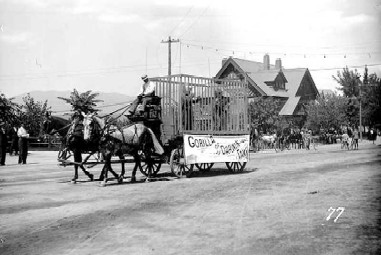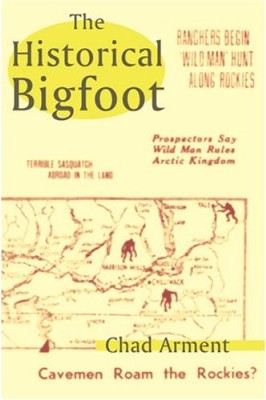Pre-1900 Gorilla Newspaper References
Posted by: Craig Woolheater on August 23rd, 2006
In Loren’s post here on Cryptomundo titled A Montana Monster, commenters asked if the term gorilla would be used in pre-1900 American newspapers. The question was also asked how this could be if the gorilla wasn’t discovered until 1902.
I showed in my post Gorilla Discovery Timeline here on Cryptomundo, that the lowland gorilla was discovered in 1847. It was the mountain gorilla that was discovered in 1902.

Below are some pre-1900 American newspaper articles that use the word gorilla to describe the creatures seen. The most common term used was wildman, but as you can see, gorilla was used as well.
Scott McClean contributed these articles. He has compiled them in a book titled Big News Prints, that is also available on CD-ROM from his website.

Click image for the full article
Click image for the full article
Click image for the full article


Click image for the full article

Click image for the full article
Click image for the full-size version of this parade photo from 1898.
Interestingly, I have just been made aware of another book covering this subject. Chad Arment, herpetologist and author of several cryptozoology books, has a new book just out titled The Historical Bigfoot.
The Historical Bigfoot covers sightings of Wild Men, Gorillas, Yahoos, and What-Is-It’s, from the early 1800s to the 1940s. Before the term "Bigfoot" was coined to signify an unknown species of North American primate, sightings of towering bipedal apes were reported throughout the continent, but called a variety of names. This book compiles and sorts the most significant sightings, but also provides a look at hoaxes, misidentifications, and the influential perspective of newspaper editors as they dealt with reports of a strange hairy manlike ape.
About Craig Woolheater
Co-founder of Cryptomundo in 2005.
I have appeared in or contributed to the following TV programs, documentaries and films:
OLN's Mysterious Encounters: "Caddo Critter", Southern Fried Bigfoot, Travel Channel's Weird Travels: "Bigfoot", History Channel's MonsterQuest: "Swamp Stalker", The Wild Man of the Navidad, Destination America's Monsters and Mysteries in America: Texas Terror - Lake Worth Monster, Animal Planet's Finding Bigfoot: Return to Boggy Creek and Beast of the Bayou.

















Good morning Craig….
Thanks for the information and the links….this helps put the hoaxes of Wallace and others in perspective…an interesting book …you have mail…
No Bucks….NO bigfoot
ole bub and the dawgs
I find this very interesting indeed. I would like to know more about the name Gorilla itself. Where did the name orginate? When and under what circumstances?
Does anyone know exactly how frequently gorillas or similar were kept and displayed in circuses during this period? From what we see here it seems it may have been quite commonplace, despite not being scientifically recognised until later.
The word gorilla was obviously well-known in the United States in the 1860’s, since general McClellan referred to president Lincoln as “the original gorilla”.
As 1847 is earlier than the 1860’s to 1890’s. The lowland gorilla WAS scientifically recognised by the time of these articles. I am also thinking considering the gorilla a ‘savage’ animal may not have helped people want to get too close.
I am also still curious as to how the specific word gorilla came into common usage. Was it a phonic deriviation of the African native name, or what?
This is very interesting and I look forward to more articles on this. Perhaps we will learn something we need to know.
This is a well done piece. The fact I was born in Newark, OH and now live 15 miles east of Port Jervis, NY, (both are represented in news articles above) made it particularly exciting for me. Thanks for putting it together.
Here is the name information:
The American physician and missionary Thomas Staughton Savage first described the Western Gorilla (he called it Troglodytes gorilla) in 1847 from specimens obtained in Liberia. The name derived from the Gorillai, a “tribe of hairy women”, described by Hanno the Navigator, a Carthaginian navigator and possible visitor (circa 480 BCE) to the area that later became Sierra Leone.
You can find anything on wikipedia
Also, those things in the parade cage do not look like gorillas to me. Need any more info, let me know.
very interesting articles
Very good article. Maybe the true beginning of reports of BF in the americas news papers.
There’s no top on the cage in the photo.
And –is that a palm tree in the background?
Edgar Allen Poe wrote “Murders in the Rue Morgue” in 1841. I though I was going to school everyone and point out that the murderer was an escaped gorilla. I re-read the story and it was an Orangutang. That’s what I get for trying to be smart.
LSU_Crypto Says:
Edgar Allen Poe wrote “Murders in the Rue Morgue” in 1841. I though I was going to school everyone and point out that the murderer was an escaped gorilla. I re-read the story and it was an Orangutang. That’s what I get for trying to be smart.
That’s what you get for going to school with Edgar Allen Poe!
afigbee Says:
There’s no top on the cage in the photo.
And –is that a palm tree in the background?
Just a coupla guys in hair suits. Very common hokum for the era.
And it’s likely not a palm, but a yound Ailanthus, or “Tree of Heaven”.
Good evening Craig.
I found the one from the 1883 edition of the “Newark Daily Advocate” to be fascinating! Not only did I go to college near Newark, Ohio (Denison University — Granville, Ohio, ’93), BUT my family has vacationed up on the Ottawa River very close to the town of Pembroke for over 25 years now!!
As a kid, camping out on my aunt’s family island on the Ottawa River, I would fantasize about coming face-to-face with a Sasquatch. The island is 16 acres, most of it wooded and rugged. On one night, some years back, when I was a teenager, I was camped out on the far side of the island by myself. Early in the morning, I distinctly heard footsteps around my tent and felt an eerie sense. I remember thinking, “What if it’s HIM [Sasquatch]?!” My better judgment took hold, and I brushed it off as a raccoon or something more believable. Nothing ever came from that encounter with whatever it was, but it made for a fun memory. Part of me wishes that I had the courage to poke a head out and look at whatever it was that night, another part of me is glad I stayed put! What if it were a bear (they have been sighted in that island cluster).
Anyway… great post – fascinating stuff!
according to my computer’s dictionary, gorilla’s origin is from an alleged African word for a wild or hairy person, found in the Greek account of the voyage of the Carthaginian explorer Hanno in the 5th or 6th cent. bc; adopted in 1847 as the specific name of the ape. At least this name actually fits the animal, most people don’t realize that kangaroo is actually aborigine for “I don’t know”. The explorers thought that when they asked what the animal’s name was, the aborigine was giving them a name, but the aborigines didn’t have a name for them.
Gorillas were the name for the Spanish resistance to Napolion’s invasion of Spain in 1806 during the Napolionic Wars of 200 years ago.
My hearing of the Kangaroo word origin is a little different. The European asks the Aborigine the name of the animal, and the Aborigine says either, “What did you say?” or “I don’t understand.” Considering your version, I’d bet on the latter being correct. I cannot imagine the Aborigines NOT having a name for a very common animal.
Straight gold strike. This may be one of the most important publications ever published on the subject. P-R-O-O-F. Ray Wallace’s family will come out and say that he died at age 162. And then Bob Hieronimus will claim it was he who was running around in costume in th 19th centruy at which point Tom Biscardi will sue him.
Some very interesting articles. Especially interesting to see how some of the reports from 140+ years ago closely mirror modern day reports.